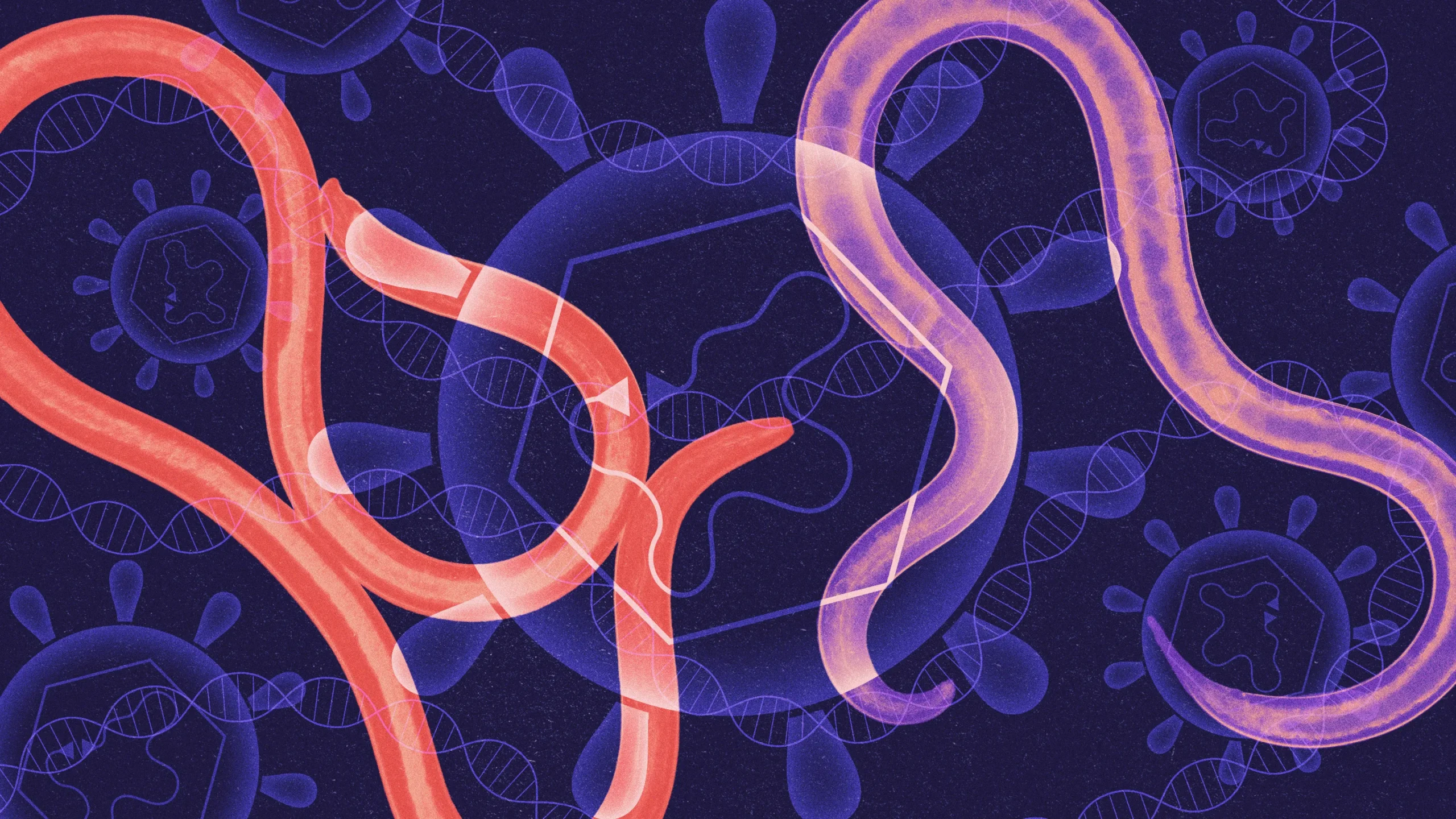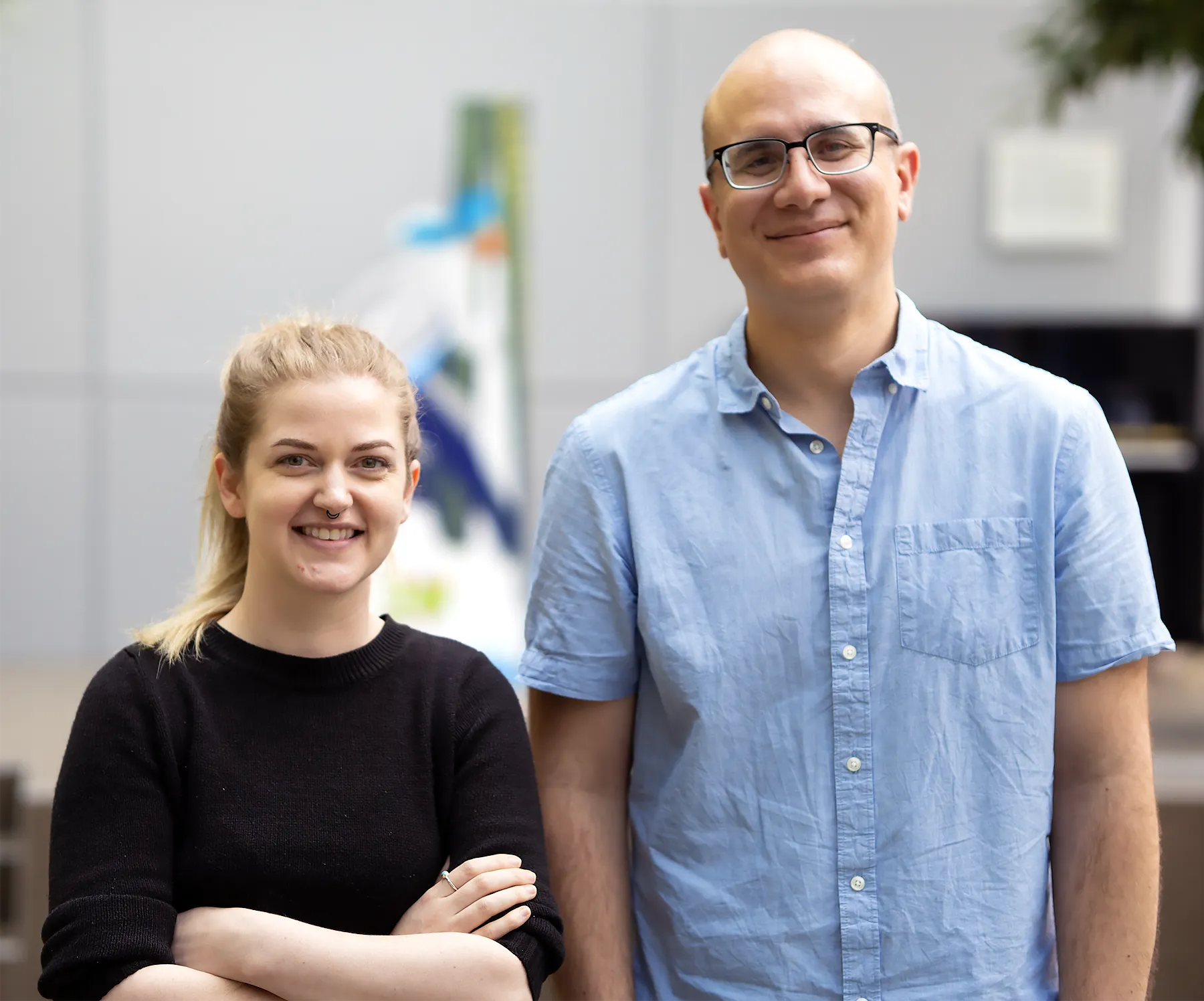Selfish, Virus-Like DNA Can Carry Genes Between Species

Unusual genetic elements called Mavericks, which can bundle a gene inside a virus-like particle, seem to have transported a gene between many species of roundworms.
Kristina Armitage/Quanta Magazine; source: Ruben Duro/Science Source
Introduction
Biologists have understood the broad contours of the rules of inheritance for more than a century: that genes are passed down from parent to child within species. But in more recent years, they have also become aware of genes that go rogue and hop laterally between species — be they frog genes in Madagascar that originally came from snakes, or antifreeze genes found in cold-water fish like herring that transferred to smelts. The mechanism facilitating this gene transfer has been unclear, though viruses were suspected to play a role.
In new research published in Science, researchers have identified a unique class of genetic elements as the agents responsible for shuttling certain genes between multiple species of simple invertebrates called roundworms. A jump from one worm to another may not sound like much, but the worms in question diverged many millions of years ago, making them as different at the molecular level as fish and humans. The genetic elements, called Mavericks, have been detected in a wide range of animals, both invertebrates and vertebrates, and they display many features found in the genomes of viruses. Given those properties, researchers suspect that Mavericks — and similar elements, including some not yet discovered — may have mediated horizontal gene transfers throughout the history of life.
While bacteria, viruses and many protists frequently exchange DNA, multicellular animals have protective barriers around their reproductive cells that generally prevent the uptake of foreign DNA. Irina Arkhipova, a molecular geneticist at the Marine Biological Laboratory in Woods Hole, Massachusetts, who was not involved in the research, said that it reveals how the “barriers can occasionally be broken” in some animal lineages to transfer genes.
For that reason, a DNA element that encodes the ability to transfer genes to the genome of a completely different species is “quite a major discovery,” said SaraH Zanders, a geneticist at the Stowers Institute for Medical Research who was also not involved in the study.
Previous studies of horizontal transfers have often focused on the mobile genetic elements called transposons. These privileged “jumping genes” can hop around the genome of an organism by replicating themselves and inserting their copies. Their sole concern is to promote their own survival within the genome rather than the fitness of the organism, which is why they are often categorized as “selfish” genes. Because roundworms have a rapid life cycle and a simple body plan, they are ideal model organisms for studying this kind of genetic parasitism.

The group leader Alejandro Burga (right), his postdoctoral researcher Sonya Widen and their colleagues at the Institute of Molecular Biotechnology realized that the unusual makeup of one Maverick in roundworms might enable it to transport genes as “cargo.”
Adam Cooper
Some roundworms carry a genetic element that is so fascinatingly selfish, the survival of offspring hinges on inheriting at least one copy of it. It contains a duo of genes, one encoding a toxic protein and one encoding an antidote that neutralizes the toxin. A mother worm that carries this element deposits the toxin in her eggs. When the eggs are fertilized, only offspring that can express the antidote gene survive. It is as if the toxin-antidote element has taken the worm’s genome hostage to ensure its propagation.
Pasting Genes Between Genomes
In 2021, when Israel Campo Bes was a graduate student at the Institute of Molecular Biotechnology of the Austrian Academy of Sciences in Vienna, he sometimes worked late on looking for genes linked to the toxin-antidote genetic elements in various roundworms. One breezy summer night at almost 2 a.m., he noticed something. The toxin gene in one worm looked almost exactly like a gene for a different function in another species of worm. They were astonishingly similar — with nearly 97% nucleotide similarity.
“It looked as if one worm had copied its genes and somehow pasted them into the genome of the other,” said Alejandro Burga, the senior molecular geneticist at the laboratory. To uncover the origin of the shared elements, Burga and team decided to examine the surrounding DNA. They spotted repeated sequences in the DNA flanking the genes — a feature of transposons that aids their jumping within a genome by ensuring that the inserted copies keep the right orientation. The team also discovered the remnants of several viral genes: one for an enveloping capsid protein, one that commonly aids viral replication, and one for a “glue” that integrates viral DNA into a host genome.
“It was like an archaeological dig — we kept uncovering clues,” Burga said.
The complete picture of the genome revealed that the shuttled gene was embedded within a set of virus-like genes and a transposon, all of which Burga recognized as making up a Maverick.
Mavericks are an ancient and fragmented class of jumping genes prevalent in the genomes of protists, fungi and animals, including humans. These massive mobile elements were initially assumed to be inactive, mutated relics of obsolete genes. But later research revealed that Mavericks can be reactivated, and that they can mediate horizontal gene transfer between some species of protists. Complete, intact Mavericks had never been characterized in a multicellular organism. The roundworms therefore presented a rare opportunity to study them.
The Maverick in one of these roundworms, however, had an additional gene — one encoding a protein called a fusogen that enables a virus to fuse with a cell and transfer its genome into it. “Without fusogen, there would be no way for the virus to transfer its genes,” said Sonya Angeline Widen, a postdoctoral researcher in Burga’s laboratory and co-lead author with Bes of the new study. The discovery of the protein strongly suggested that this Maverick had the ability to form a virus-like particle and invade different cell types.
Mavericks Do the Unorthodox
Burga’s team quickly mined the roundworm genome database for other examples of genes embedded like cargo for transport in Mavericks. It soon became evident that the one they had found was not an isolated case of horizontal gene transfer. In more than 100 roundworm genomes spanning 11 or more genera, two families of genes had often been taken up as cargo by the Maverick particles and extensively transferred between species. Complete and incomplete remains of the genetic elements permeated different worm populations around the globe, from North America to India to a kilometer-deep gold mine in South Africa.
Although the circumstantial evidence strongly suggests that this Maverick enabled the horizontal transfer of genes between the roundworm species, researchers have not yet caught it in the act. Burga and his team recognize that their important next step will be to find a way to induce virus-like Maverick particles to form while they observe them under a microscope.
The work could have a practical benefit. Many roundworm species are parasites that infect agricultural crops and livestock. If researchers understand how Mavericks work, it might be possible to use them to control the parasites by introducing genes into them.
“It is not something we can do right way,” Burga said, “but hopefully in a few years.”
There is reason to believe that gene transfer using massive transposons may be more common in nature. Recent research led by Aaron Vogan of Uppsala University in Sweden has found massive mobile genetic elements called Starships that shuttle genes around in multiple species of fungi. Vogan suspects that Starships transferring key genes between fungal pathogens may have created the new strains that cause rolling epidemics of wheat diseases, such as tan spot (yellow leaf spot). The diseases have caused major crop losses worldwide since the 1970s, with over 50% loss of harvest in extreme cases. “So understanding the dynamics of changes in genome from such horizontal gene transfer has impacts all across biology,” Vogan said.
Researchers have come to appreciate that transposon-like genetic elements are “key drivers of genome evolution,” Zanders said. To really understand genomes, we must understand these “selfish elements” that can jump between species, she added.
Correction: November 15, 2023
An earlier version of this story misattributed a quotation by Alejandro Burga to Israel Campo Bes.






